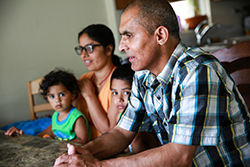As we approach the end of the federal government’s fiscal year on Sept. 30, the Administration is considering how many refugees to welcome in 2021. Although refugee admissions have gone down each year of the current Administration, we know refugee admissions have not been eliminated due to strong advocacy – particularly from the faith community. Reflections from our summer intern give us background and conclude with an opportunity for us to again respond with impactful advocacy as the calculation is being made.
RAISING THE REFUGEE CEILING
By Jenn Werth, summer intern with ELCA advocacy
According to the United Nations High Commission for Refugees, the number of refugees on the African continent has nearly tripled over the past decade, yet the number of refugees the United States admits every year has continually fallen. As a church dedicated to supporting compassionate survival assistance and vigorous international protection for refugees*, it is essential that we hold our country responsible to increase the number of refugees it admits**.
Lutherans have a strong history of providing hospitality to refugees resettling 57,000 refugees in the United States post World War II, resettling 50,000 refugees from Vietnam, Cambodia, and Laos after the fall of Saigon in 1975, and providing sanctuary for refugees endangered by wars in Central America in the 1980s***. Today the ELCA remains active in many ways, including through its AMMPARO program, Accompanying Migrant Minors with Protection, Advocacy, Representation and Opportunities. AMMPARO helps ensure basic human rights and safety of migrant children from El Salvador, Honduras and Guatemala.
With such a deep focus on the accompaniment of immigrants and refugees in one small part of the world, it can be easy to lose sight of the international expanse of refugee populations. In 2019 alone, the Lutheran World Federation supported 1.3 million refugees and internally displaced persons, most of whom reside in African countries including but not limited to Uganda, South Sudan, Ethiopia, and Cameroon. We as a church can be a strong voice for both the refugees we work with close to home and the refugees we support from countries across the globe. As it is written in Leviticus 19:34, “The alien who resides with you shall be to you as the citizen among you; you shall love the alien as yourself, for you were aliens in the land of Egypt”.”
Immigration, refugee and asylum policies not only can be evaluated against who we are as a church, but also express our character as a nation. As the United States commits to receiving fewer and fewer refugees every year, dropping from 45,000 in 2018 to 30,000 in 2019 to 18,000 in 2020, our country is not meeting the expectations we as a church have for a generous policy of welcome. The Lutheran Immigration and Refugee Service (LIRS) calls on Congress and the current Administration to raise that ceiling to 95,000 refugees. As advocates for generous immigration and refugee policies, we can use our voices to support the efforts to raise our refugee ceiling rather than allow further reduction.
* ELCA social statement For Peace In God’s World, pg. 20
** ELCA social message on “Immigration,” pg. 9.
*** “Immigration,” pg. 3
TO LEARN MORE
See “Frequently Asked Questions: Refugee Ceiling and the Presidential Determination” prepared by LIRS.
ACTION OPPORTUNITY FOR ROSTERED MINISTERS:
Over 240 rostered ministers urged the president and Secretary Pompeo to commit to resettling 95,000 refugees in fiscal year 2021 by signing a Sept. 24 letter prepared by the ELCA AMMPARO and Lutheran Immigration and Refugee Service (LIRS) advocacy teams.
TWO OTHER OPPORTUNITIES FOR FAITH-BASED ACTION organized with the Interfaith Immigration Coalition in which the ELCA participates:
Join the #RefugeesWelcome2021 Campaign. Encourage your state and local elected leaders to express support for welcoming refugees by signing onto this letter.
Write letters-to-the-editor (LTEs) for your local media outlets. Here is a sample LTE that you can use/adapt for your message, as well as step-by-step instructions for how to draft, pitch, and place an LTE. Please contact media@interfaithimmigration.org if you have any questions or need help.

